The Intimate Relations of Creating Knowledge Together
Introduction: Skin to Skin
When philosopher Barbara Schellhammer travelled to the Canadian Arctic to visit the community of Ulukhaktok in 2006, she was invited to join an ice fishing trip. Barbara was interested in Inuit philosophy. She knew that this philosophy is not a matter of abstract thought, but engrained in meaningful activities like travelling, fishing, and sharing. As it happened, Barbara came to suffer from frostbite on her feet and had to return to the settlement before long. There, one of her hosts asked her to undress her cold feet and did not hesitate to pull them under her clothes and press Barbara’s frostbitten toes against the skin of her own belly, thereby sharing her personal warmth with the stranger’s freezing body. She didn’t say much and certainly did not produce any ready-to-use quotations that would lend themselves to written publications. Initially, Barbara was embarrassed, not only feeling that she had been inadequately prepared for the fishing trip, but also because she was now skin to skin with a person she hardly knew (Schellhammer 2015, 257–64). However, she soon realized that what she had experienced during this failed fishing trip was genuine Inuit philosophy in action, and also came to see that research collaboration goes far beyond the rational production of facts.
Barbara shared this story during a workshop at the Global South Studies Center (GSSC) of the University of Cologne in November 2024. This workshop brought together eighteen participants interested in co-producing knowledge with Indigenous research partners, including three European scholars involved in research with Indigenous Peoples in northern Canada and myself: Alestine, a Dinjii Zhuh anthropologist and the first author of this blog post. Dinjii Zhuh translates as “the people from around here” and refers to Northern Canadian and Alaskan Indigenous People also known as the Gwich’in Nation. I co-authored this blog post with Franz Krause, my host in Cologne, who had been lucky to receive university funding for inviting me and organizing the workshop. Franz had been hoping that having a senior Dinjii Zhuh researcher participate in university events and city life in Germany, just as he occasionally participated in Dinjii Zhuh events and life in the Gwich’in Settlement Area (GSA) during his fieldwork, would improve mutual understanding and would support more symmetrical relations for creating knowledge together.
In this blog post, we will share some of our experiences of the fellowship and summarize the discussions we had at the workshop. We realize that research relations come in all shapes and forms, but in this text we want to highlight the intimacy that people may develop when they are engaged in research with Dinjii Zhuh traditional knowledge. Such work is never just a purely cognitive process of collecting information but, rather, about real people working together, getting to know each other, working around misunderstandings, spending time together in houses, tents and vehicles, and learning to live with each other’s personalities, habits and—as in Barbara’s example—body temperatures.
Research Fellowship at the University of Cologne
At the time of the workshop, I was visiting the University of Cologne as a Research Fellow at the university’s Multidisciplinary Environmental Studies in the Humanities (MESH) hub for three months. As a retired cultural director and heritage researcher with the Gwich’in Social and Cultural Institute (GSCI), now the Gwich’in Tribal Council’s Department of Cultural Heritage (GTC DCH), I have assisted in conducting, coordinating, and reviewing a long list of research projects with Dinjii Zhuh in the GSA in the Canadian Western Arctic over the years. Having grown up in and around the Gwichya Gwich’in community of Tsiigehtchic, my work with what later became the GTC DCH began in 1992, when I was hired, alongside a Euro-Canadian anthropologist, to conduct social research on Gwich’in place names in the context of possible hydrocarbon extraction projects. Over the two decades since then, I have been involved in numerous initiatives to record and publish place names and the narratives that belong to them, ethnobotanical knowledge of plants and their uses, Elders’ biographies and stories, and many more research projects.
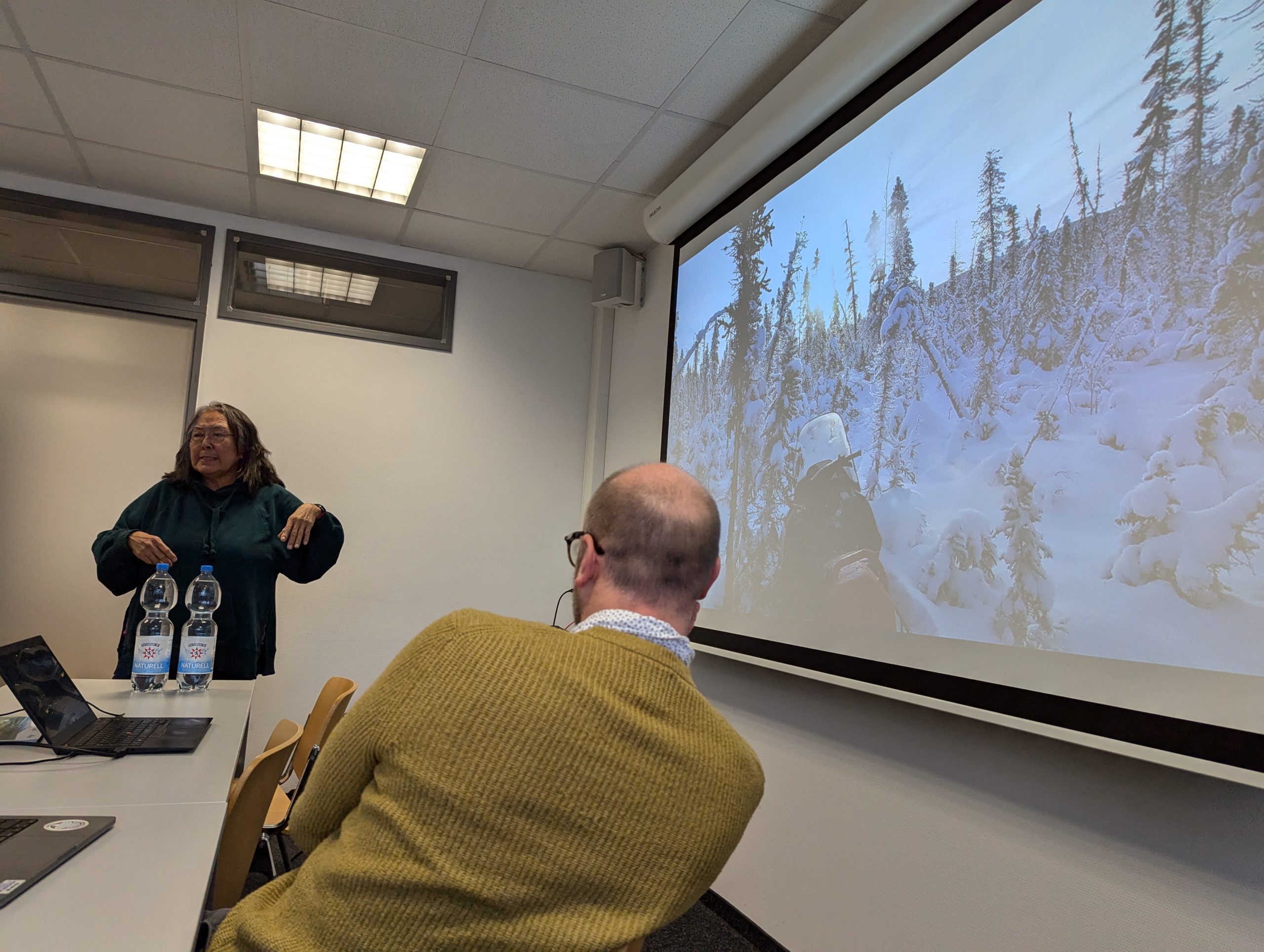
Alestine Andre and Peter Loovers discussing ways of learning and knowing at the Cologne workshop, November 15, 2024. Photo by Franz Krause.
My fellowship in Cologne enabled new conversations that would have been less likely to happen if the researchers would have visited the GSA individually and discussed their specific research projects there. One reason for this was that the discussions were held with a group of researchers based in different institutions and disciplines rather than with one or more Dinjii Zhuh and a single outside researcher. Another reason was that the location at a European institution reversed the standard setup where the foreign researchers would travel to their Dinjii Zhuh counterparts to speak to them while on Gwich’in lands. This reversed setup has the potential to enable more symmetry in research collaborations than standard arrangements. During my arrival and time as a Research Fellow in Cologne, I remember how I felt almost like the new surroundings swallowed me up into a foreign environment. This included the currency, the language, the food, the street names, travel by train, and the city layout. I had to learn very quickly how to recognize distinctive features of buildings as landmarks in order to navigate my way to the university, to the nearby grocery store, and to neighborhood main street areas. Unlike in the wide-open landscapes at my home in Tsiigehtchic, on the Mackenzie River, at my summer fish camp, or even in the city of Whitehorse, Yukon, I felt closed-in by the many tall and long buildings surrounding me, the narrow and crowded streets, many store shoppers, and the fast-moving bicycles and corresponding bicycle lanes on the sidewalks. I felt very lucky that most service people I encountered spoke English. The people I met were helpful, so I was able to get by.
Although I never felt uneasy or unsafe as I carried on my daily life outside the University’s guest house, I must admit that my instinct was on high alert all the times. Researchers from outside the GSA tell me that they often experience rather similar things when they first come to work with us in the North, and I think that it helped me understand their situation better. If they, too, are challenged and overwhelmed by the unfamiliar surroundings when they come to learn with Dinjii Zhuh, they might be equally as dependent on the small gestures of support and courtesy that I appreciated so much while getting used to life in Cologne.
The fellowship in Cologne and the workshop at its center contributed to a wider set of initiatives at the GSSC, experimenting with ways that may enable more symmetrical forms of knowledge production and attempting to minimize epistemological as well as other hierarchies between researchers and research participants. In Canada and elsewhere, Indigenous groups have established administrative capacities for managing research activities in their territories and with their members. For example, the Dinjii Zhuh, who inhabit a large area in what is today north-eastern Alaska, USA and the Yukon and Northwest Territories in Canada’s North, have very successful institutions that direct research projects. In particular, on the Canadian side of their lands, the Gwich’in of the Northwest Territories have formed the GSCI for governing any research that has to do with traditional knowledge, be it anthropological, historical, geological, meteorological, or based in any other discipline.
The GSCI was established in 1993 after the successful Gwich’in land claim negotiations with provincial and federal Canadian governments that resulted in the Gwich’in Comprehensive Land Claim Agreement in 1992. In this part of Canada, land claims were made in the late 20th century when Indigenous groups could no longer bear that their older treaties or other agreements with the Canadian governments were not taken seriously in an era of rapid resource extraction. Today, many land claim organizations receive some funding from the Canadian governments and have more or less extensive rights to decide what happens in their traditional territories, and this includes research activities on their lands. Originally, the GSCI was not part of the financial structure that resulted from the Land Claim Agreement but had to generate its own funding by applying for research grants and other support. More recently, the GSCI has been transformed into a department of the Gwich’in Tribal Council and continues to manage research with and for Dinjii Zhuh, their language, culture, knowledge, and lands.
This means that whoever is interested in conducting research on anything that might touch on traditional knowledge in the GSA has to report to—and will be supported by—the Department of Cultural Heritage. The researchers at the Cologne workshop who had worked in the GSA had all collaborated with the GSCI/DCH in the past. For example, I had helped Franz to set up and conduct his project. During his first trip to the GSA, I directed him to make his way to a grocery store in the regional center, Inuvik, where I would later pick him up accompanied by another research partner. I had previously emailed him a long shopping list to get supplies for an exploratory trip that we would embark on, including a large frozen turkey to celebrate U.S. Thanksgiving day with my cousin from Alaska, who was also visiting. Franz spent his first nights in a spare room at my house. While we visited various community representatives during the days, we spent the evenings cooking and enjoying food, playing Scrabble, and discussing possible research sites, not just among the two of us but with other visitors at my house, too, including my Alaskan cousin, a researcher from Israel, a nurse who was born in Cameroon, and the hamlet’s Senior Administrative Officer who hailed from Jamaica. While I opened my doors to numerous prospective and current researchers over the years, the GSCI’s work also facilitated the opening of many other doors into Dinjii Zhuh houses, camps, tents, and family lives.
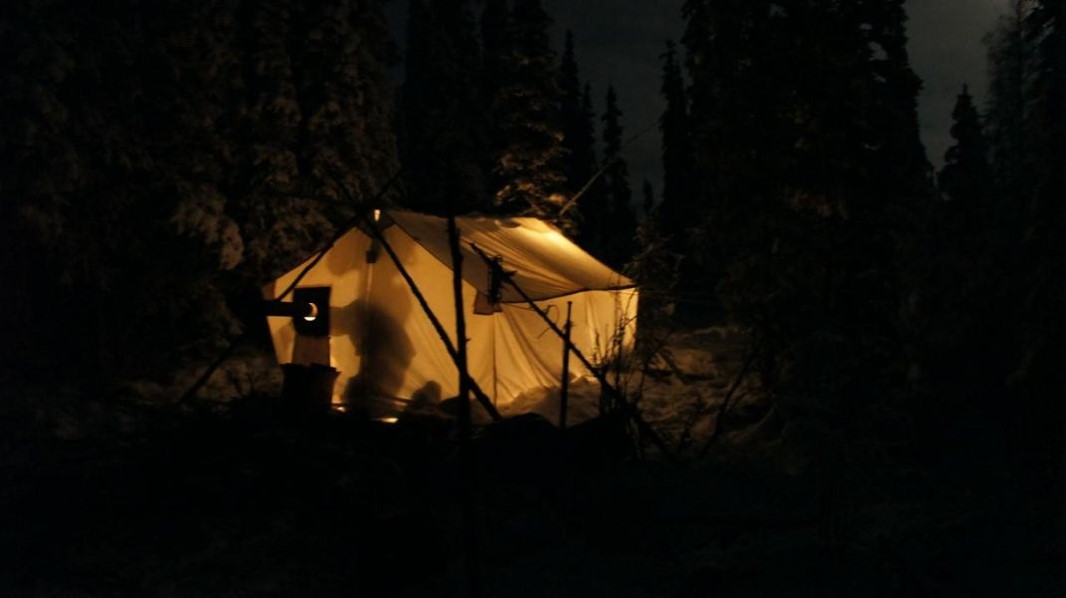
Abraham Stewart Junior’s canvas tent near Naghaii Zhoo Tsal (Frog Lake) in the Gwich’in Settlement Area, November 2011. Photo by Peter Loovers.
From Regional Place Names to International Research Collaborations
At the workshop, I presented the history of the GSCI and DCH, placing particular focus on the role of Dinjii Zhuh Elders in sharing their knowledge about place names, ethnobotany, genealogy, and language. I illustrated that the GSCI/DCH, as an Indigenous-led research body, is not automatically privy to all Gwich’in traditional knowledge but that such knowledge is distributed unevenly, with some Elders holding more or different knowledges than other community members. Franz thought this was a powerful reminder that communities and their knowledges are not homogeneous. Among the Dinjii Zhuh, just as among many communities around the world, there is a concern that valuable traditional knowledges are being lost as ways of learning, livelihoods, technologies, and social relations change, and younger generations seem to lose touch with their Elders. The GSCI/DCH was created—and keeps working—towards bridging this gap, documenting traditional knowledge, and making it available for teaching and learning among younger generations. This dedication is echoed also in the way the organization collaborates with non-Gwich’in researchers, who are engaged as supporters of this project to document and share traditional knowledges.
My presentation was titled “Gwich’in Elders Sharing Stories with GSCI/DCH and Outside Researchers over the Decades.” I told the story of how Dinjii Zhuh place names—that were nearly lost by 1992—were reclaimed through place-names and oral-history research that we carried out through the GSCI with Dinjii Zhuh Elders and traditional land users over two decades. This project was initially funded by the oil and gas industry that was keen on constructing a massive pipeline along the Mackenzie River and needed to know the region’s topography and archaeology better. The place names project was just one example of the variety of research carried out over the years, funded by a large variety of sources and carried out by a large team of researchers, some of them Dinjii Zhuh, others outsiders, many of whom became close friends. From 1993-2015, the GSCI interviewed more than seventy-four Dinjii Zhuh Elders and traditional land users ranging in age from fifty-five to ninety-five years and recorded almost 1,000 Dinjii Zhuh place names and associated information. The research was carried out in the four Gwich’in communities of Aklavik, Inuvik, Fort McPherson, and Tsiigehtchic as well as on the land and on the three major rivers that run through Dinjii Zhuh lands: the Mackenzie, Arctic Red, and Peel Rivers.
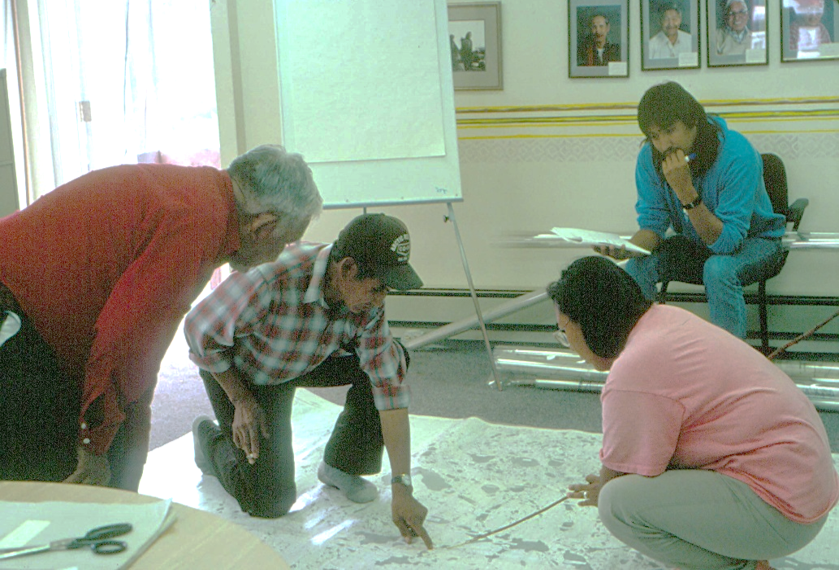
Gwichya Gwich’in Elders, Hyacinthe Andre and Gabe Andre, pointing out named places and trails on a 1:50,000 scale map to Dinjii Zhuh researcher Alestine Andre and Dinjii Zhuh linguist William George Firth, during the 1992 Place Names Project in Tsiigehtchic, Gwich’in Settlement Area. Photo credit: Ingrid Kritsch, Gwich’in Social and Cultural Institute-Gwich’in Tribal Council.
There have been many outcomes of the place names project and other research, beyond documenting for the future. These include the exchange of knowledge between Elders and youth; helping build a comprehensive heritage inventory to ensure that culturally significant heritage sites and places are recognized, protected, and managed in a manner consistent with Dinjii Zhuh values; providing information for several award-winning publications authored by Dinjii Zhuh researchers and their collaborators, and used by educators and scholars; the official recognition of Dinjii Zhuh place names by the Canadian federal government; the creation of an online interactive Gwich’in Place Names and Story Atlas and the publication of An Indigenous Place Names Handbook – Sharing the Gwich’in Experience in Canada (Andre et al. 2023).
Since 1993, the GSCI/DCH carried out over 130 research projects, working alongside Dinjii Zhuh Elders and experts to preserve Dinjii Zhuh culture and fulfil the heritage goals of the Gwich’in Comprehensive Land Claim Agreement. These projects included ethno-archaeology, Dinjii Zhuh ecological knowledge of species at risk, Elders’ biographies, Dinjii Zhuh language resources and ethnobotany. GSCI researchers and managers also worked with 40 graduate students and researchers from universities in Canada, the United States, Europe and the Middle East. Many students and researchers brought their own research interests and methods, but they all adjusted their work in conversation with the GSCI mission, and added their findings to the growing stock of GSCI research data.
The GSCI carried on with its research projects while facing several challenges. One of them had to do with time: We were working with the last generation of Elders who had spent much of their lives on the land, and we felt it was essential to document some of their knowledge before they passed away. Today, Dinjii Zhuh people spend most of their lives in settlements, where schools, government services, and wage-work structure their daily routines and knowledges. Elders who had known a different way of life—moving between temporary seasonal camps on the land throughout the year and only visiting the settlements for certain occasions and festivities like Christmas and Easter—were passing away quickly, and there was an urgency to document their land-based cultural knowledge. Also, Dinjii Zhuh Ginjik (the Gwich’in language) was in a critical state, with a radically declining number of fluent speakers, so a further emphasis was placed on recording the language as much as possible.
Extensive fundraising was carried out yearly to cover both core operating costs and projects costs. Over the years, we managed to get grants from the Canadian government for cultural and archival projects, research funding through partnerships with Canadian universities and corporations, support from the regional school board for educational initiatives, and funds raised by the GTC to support cultural programs. This enabled the recording and passing on of traditional knowledges and improvements in the areas of language revitalization in Dinjii Zhuh communities. Whereas Dinjii Zhuh Ginjik and traditional knowledge have long fascinated outside researchers, not all of them are remembered fondly in the communities. Some people say that while particular researchers did know how to give back after receiving support and inputs from Dinjii Zhuh, others did not. Building up Dinjii Zhuh research capacity meant that collaborations with outside researchers, who are still involved in most of the research in the GSA, could be designed on our own terms. It facilitated the development of a protocol and review procedures for external research that drew on Dinjii Zhuh traditional knowledge as well as multiple collaborations with researchers from across Canada and, indeed, the world.
Doing Research as Learning Together
One of these was anthropologist Peter Loovers, who had been doing research with Teetł’it Gwich’in—the group of Dinjii Zhuh living in and around Fort McPherson and the Peel River—for close to 20 years at the time of the workshop. His fieldwork included concerted efforts to learn Dinjii Zhuh Ginjik as well as Dinjii Zhuh skills and knowledges alongside other younger people in Fort McPherson who were struggling to continue valued ways of speaking and doing things in a quickly transforming world and despite recent colonial policies aimed at obliterating Indigenous languages and cultures (Fraser 2024). These efforts at speaking Dinjii Zhuh Ginjik earned him the nickname “Gwich’in Peter” in the community. In his presentation about Gwich’in education, he pointed out that Alestine was one of his most important educators, from the very early stages of his project when he worked on his research questions and methods to the interpretation and analyses of his findings.
Peter has come to see research as a form of education, and he considers his work with Teetł’it Gwich’in as formative not only in a professional sense but also on a personal level. In conversations with GSCI staff, Peter also conceptualized his research as a way of addressing the widening gap between Dinjii Zhuh Elders and youth and between ways of life geared at the so-called “bush economy” (as the livelihood related to hunting, trapping, and gathering berries and other resources is called) and the “wage economy.” This also meant that he did not find it useful to define any particular research focus, preferring to remain open to learning whatever the Dinjii Zhuh Elders wanted to teach him. In the process, he learned not to ask many questions, instead letting his research participants lead the direction of their teachings, not only in conversation but above all in watching his teachers and learning their practices. Peter’s doctoral research had been funded by a university scholarship and he was therefore able to pursue this open approach. Many other funding agencies require researchers to define a focused research question and proceed to answer it using the least amount of time and resources possible, which would systematically hinder Peter’s research strategy.
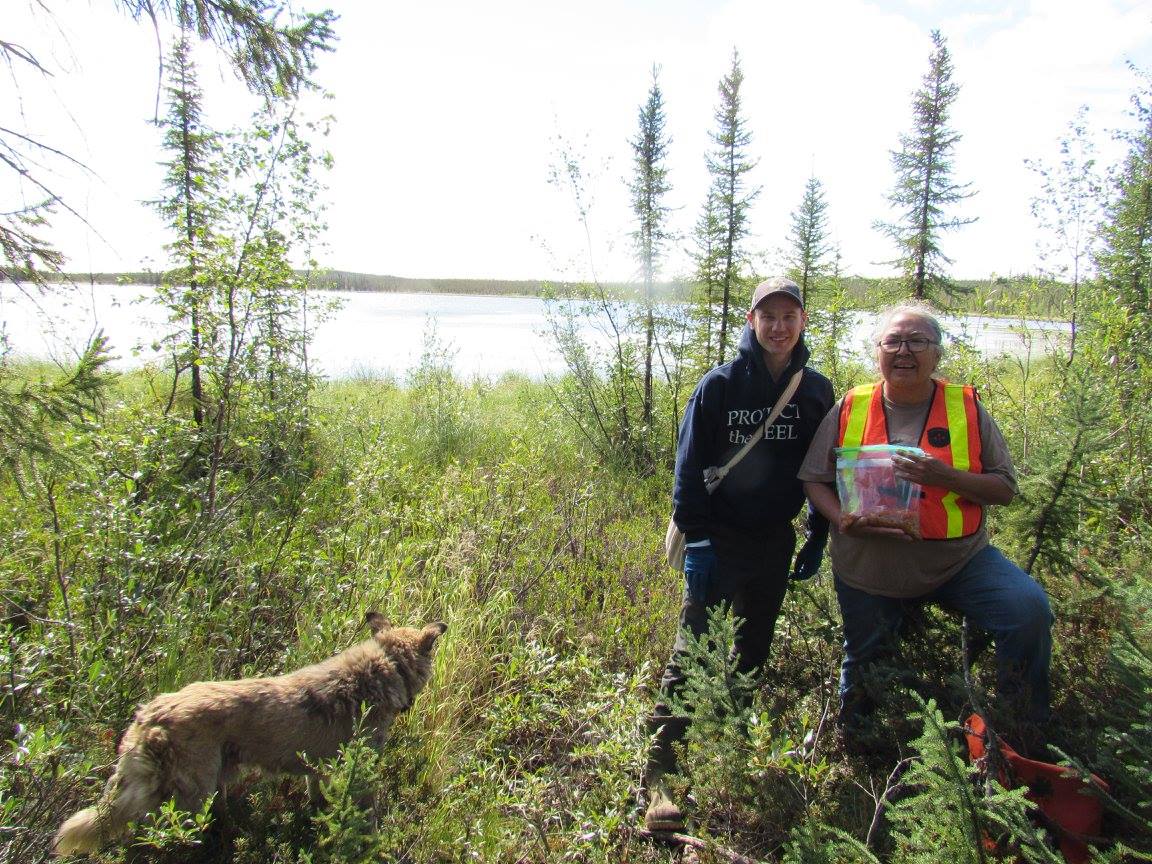
Alestine Andre, Peter Loovers, and dog łuhchìl near the helipad in Tsiigehtchic, Gwich’in Settlement Area, picking nakal or yellowberries (cloudberries), August 2016. Photo by Sharon Snowshoe.
Peter focused his presentation around three Dinjii Zhuh words for different ways of knowing, all of which fall under the single word “knowledge” in English (see also Loovers 2019). Gihk’agwaanjik is knowledge that a person discovers on their own, by their personal experience; gatr’oonahtan is knowledge taught by one person to another; and gahgwidandai is common knowledge that many people share. That the English term “knowledge” can be translated into different terms meaning a number of different things is not unusual. Take, for example, the German words wissen (to know factually) and kennen (to be familiar with) that refer to different aspects of knowing or the ancient Greek words epistēmē (theoretical knowledge), technē (technical skill), mētis (strategic wisdom), and gnōsis (personal insight). Each way of knowing knowledge, however, configures in specific ways what knowledge is and how it can be acquired or communicated.
Peter illustrated that his own knowledge of Dinjii Zhuh ways of knowing was of the gatr’oonahtan kind, specifying the two teachers with whom he most intensely discussed these terms (one of whom was Alestine). Dinjii Zhuh education—and research—means engaging with all of these forms of knowledge and continually taking the humble position of a learner who does not claim expert status but is open to discoveries, teachings, and common sense. Interviews can only help acquire limited aspects of these forms of knowledge; hence, watching and learning practices like cutting wood and making trails are as necessary as listening to stories and documenting biographies. Peter also emphasized the ethical dimensions of this education, again highlighting a lesson that Alestine had given to him which explained that researchers will always be visitors. In Dinjii Zhuh communities, visitors are warmly welcomed, appreciated, and supported. But it is up to the researchers themselves whether they want to be good visitors or bad visitors, and following Dinjii Zhuh principles of education—rather than executing research methods from elsewhere—is part of being a good visitor.
Barbara continued in a similar vein, arguing in her presentation that creating knowledge in symmetrical relationships must be based on being there for each other, responding to each other’s needs and capacities rather than stubbornly implementing predetermined methods and filling out questionnaires. Her story about her frostbitten feet was a powerful example of this, but since then Barbara had tried out other forms of knowledge co-creation, including the dialogical authorship of a book with Opaskwayak Cree educator Stan Wilson. Indigegogy (Wilson and Schellhammer 2021) is a conversation between Stan’s argument about a decolonial form of education and Barbara’s comments and reflections. In her presentation, Barbara related the classic Greek concept of parrhesia (the courage to know and speak the truth) to her struggles in learning with Indigenous people in Canada as a European researcher trained in philosophy, a discipline that seems to revolve around the thought of white men, always referring back to Aristotle. Her work approaches this relation not as a project of allegedly validating Indigenous knowledges through European philosophical traditions but rather as a journey of collaboration that actively avoids the continuing colonial structures of knowledge production. Barbara argued that if all involved parties can summon the courage to also know inconvenient and uncomfortable truths and if they proceed with a good heart and mind, Indigenous and European researchers will find ways of learning together and moving forward despite hurtful colonial histories and continuities.
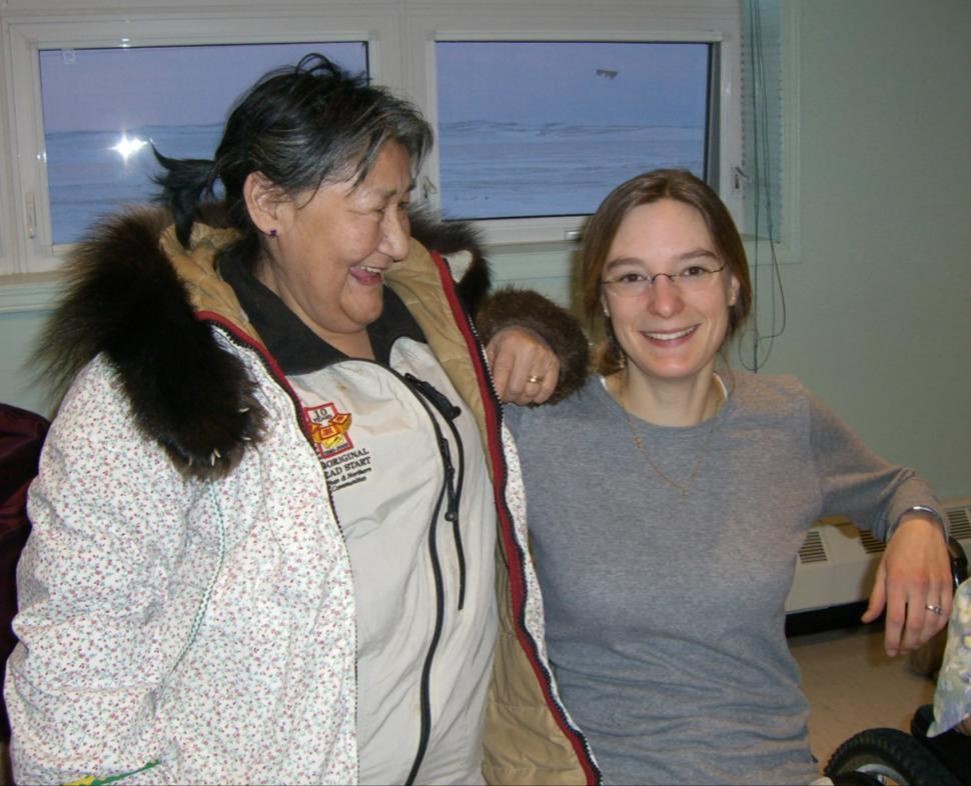
Barbara Schellhammer with an Inuvialuk host at a community meeting in Paulatuk, Inuvialuit Settlement Region, December 2006. Photo likely by Patricia Davidson.
Formal and Informal Dimensions of Knowledge Co-Creation
Franz, who had worked with the GSCI/DCH since 2015, reflected on his experiences with formal and informal collaborations that structured his ethnographic research in the Mackenzie Delta on the border between the GSA and the neighbouring Inuvialuit Settlement Region. In order to conduct research in the region, scholars need approval from various authorities. The Land Claim Organisations have the right to grant or withhold support for projects in their respective territories, and the Government of the Canadian Northwest Territories is tasked with running a research licensing procedure that permits research only if approved by the affected communities and if the project has undergone an institutional ethics clearance. Alongside the Government’s research licence, Franz’s project required approval from the Gwich’in Tribal Council and the Inuvialuit Regional Corporation (IRC) with their various agencies and departments. While the IRC mandated, among other things, an environmental impact screening and a conversation with the local Hunters and Trappers Committee, the GTC DCH provided a detailed “Traditional Knowledge Policy” that explained, for example, how they understood research and informed consent as well as other guidelines that researchers were asked to follow. These guidelines included useful suggestions about how best to inform people about planned research, being present in the community, and ways to recruit research participants. It also spoke of courtesy and adjusting to community habits, such as suitable timings for visits and interviews.
Franz also discussed the mixed blessing of the ethics reviews, which on the one hand raised a series of relevant issues, including the safety of research participants and researchers, but also came with a number of formal conditions, including the requirement to fill out written informed consent statements with people involved in participant observation. Interrupting spontaneous, informal conversation in order to read through a formal document and ask for people’s signatures before the conversation can continue and become part of a research project’s data may not only deter research participants but is also likely to feel grossly inappropriate, if not very impractical, as anyone who has ever attempted to go through an informed consent form in a poorly lit place while wearing mittens would know. In many instances, it can be more appropriate to talk about the purpose of one’s research on the local radio show, as suggested by the DCH research guidelines. While some of the evaluation of the research plans thus came from the Inuvialuit and Dinjii Zhuh with whom the research was to be conducted, others—including research managers in the territorial government in the far-away capital or Land Claim administrators in the urban centre of Inuvik or other parts of the GSA—also had important roles and their standards also had to be satisfied.
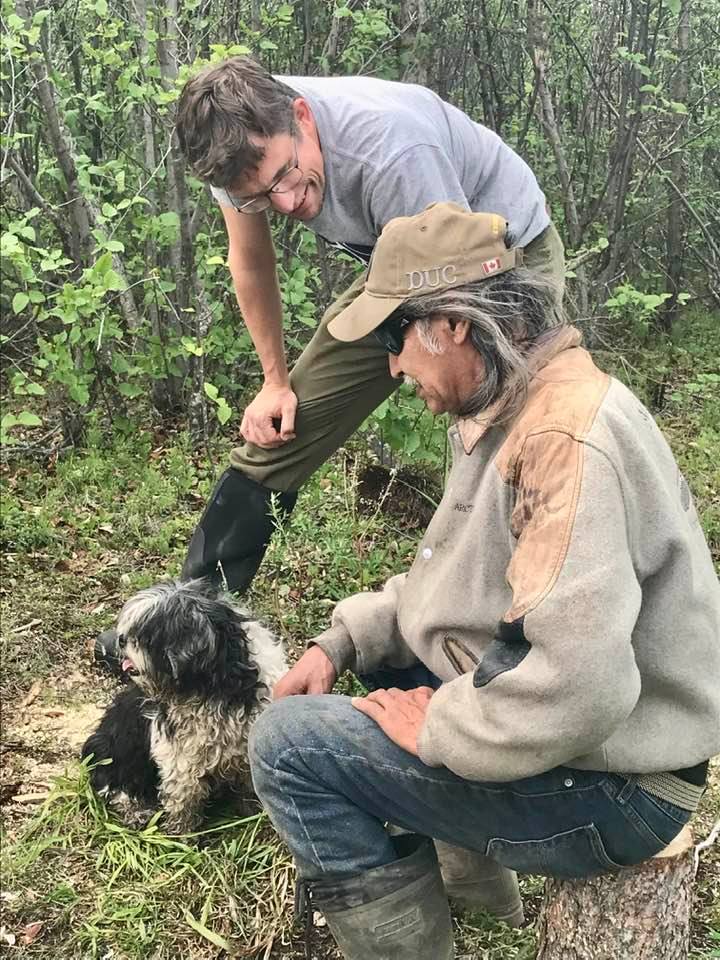
Norman Kendi and Franz Krause with dog Winston outside of Aklavik in the Gwich’in Settlement Area, summer 2022. Photo by Samantha Kerr.
Good research practice in Northern Canada includes reporting key project findings back to the communities with whom the project has been realized. The DCH even provides a formal data release agreement. Franz shared drafts of his manuscripts with Dinjii Zhuh and Inuvialuit partners asking for their feedback, often getting very useful and sometimes detailed suggestions as part of these reviews. Generally, however, these formats seemed to be as much about the integrity of the researcher themselves as they were about the correctness of the research outcomes. In other words, it was not only important that the manuscript got the facts right and did not reproduce any stereotypes or misunderstandings but also equally significant that the researcher had behaved properly during the project, treated research participants respectfully, and was associated with other respected people such that the researcher as a person was considered trustworthy. For example, Franz’s initial building up of relations in the Mackenzie Delta was immensely supported by the fact that he was friends with “Gwich’in Peter” whose friendly and professional presence in the region many people remembered.
Franz illustrated that research permits and publication screenings in Arctic Canada involve social relations, communication, and trust at various scales. Multiple organizations and institutions—from the territorial government and various Land Claim offices to different people in the communities—participate with sometimes different agendas and standards. He concluded that while he wholeheartedly supported the licensing process that formalizes Indigenous research partners’ stakes in knowledge production, he had also learned that this process does not always bring researchers closer to the concerns of those people from whom they are hoping to learn. Instead, formalized requirements and protocols, while protecting communities from extractive research, focus energy and accountability towards particular official gate-keepers, thereby potentially sidelining the interests and agency of the people who actually participate in the research. Formal procedures provided a safe space for building the intimate relations of creating knowledge together, but they also unfolded on a rather different scale and manner.
Co-Created Knowledge as a Gift to be Passed On
Reflecting on the workshop, I was pleased and honored to have this exchange with researchers whom I had assisted and introduced to Dinjii Zhuh communities when working with the GSCI. Listening to the stories about the researchers’ time with community people and their travels on the land made me long for home. I recognized the names of many people from my area whom the researchers had spoken or worked with. I found that the researchers’ experiences and first-hand accounts succinctly captured Dinjii Zhu and Inuvialuit ancestral knowledge, ways of being with the land, and cultural teachings, all of which continue to be passed down through oral tradition. This knowledge is shared with family and community members and visitors alike, and it was also presented and spread by the researchers at the workshop in a similar vein.
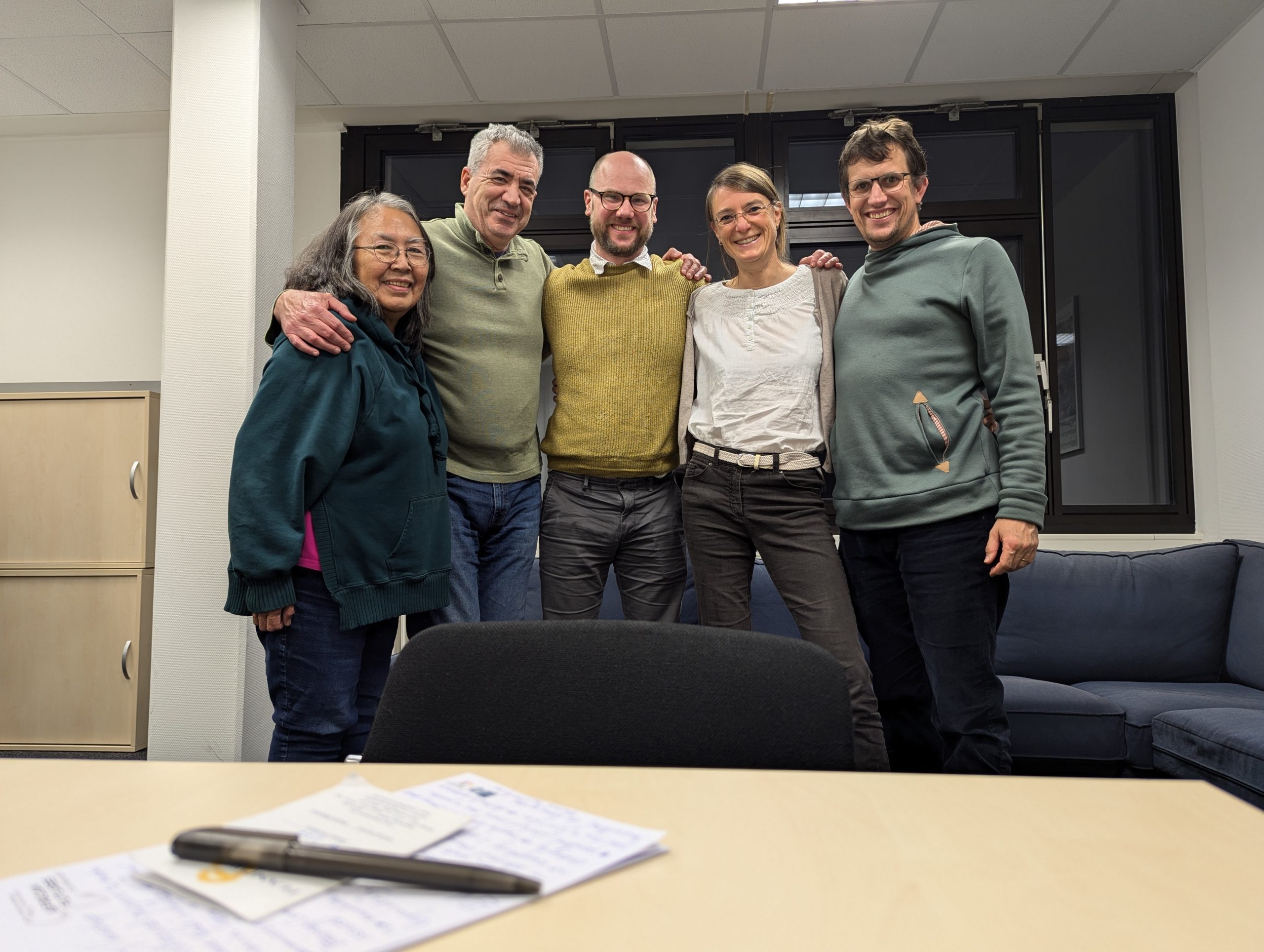
Common knowledge production unites: Alestine Andre, Itai Katz (Alestine’s husband), Peter Loovers, Barbara Schellhammer, and Franz Krause after the Cologne Workshop, November 15, 2024. Photo by Franz Krause
Reflecting on my fellowship at the University of Cologne as a whole, I thought it provided an opportunity to see a more encompassing picture of the research work carried out by, and with, the GSCI/DCH with Dinjii Zhuh community Elders and land users. I must always emphasize the pivotal role of Dinjii Zhuh Elders in the research collaborations, whose willingness to share their life stories gave me and other GSCI researchers a boost to document their rich land-based cultural knowledge for future generations. The GSCI was built, on the one hand, by eager Elders wanting to share their stories, and on the other hand, by research staff who had an appropriate training and background to document traditional Dinjii Zhuh ways of life on the land. The Elders have indeed left a precious gift for future generations and other people to learn from. Collaborative research can be seen as a means of documenting and passing on this gift across time and space. The gift includes place names, ethnobotanical knowledge, language, and philosophies as well as the warmth of one’s body to treat another person’s frozen feet. Dinjii Zhuh researchers, their collaborators from other parts of the world, and Gwich’in youth and Elders all play their part in handling this gift: learning, experimenting, struggling, understanding, guiding, and teaching—together. Reflecting on the possibilities and challenges of horizontal and collective knowledge production, the workshop participants continued to come back to the intimate personal relationships that evolved as part of the shared learning process.
References
Andre, Alestine, Ingrid Kritsch, Kristi Benson, and Sharon Snowshoe. 2023. An Indigenous Place Names Handbook: Sharing the Gwich’in Experience in Canada. Natural Resources Canada. https://natural-resources.canada.ca/sites/nrcan/files/pdf/SharingGwichinExperience-en.pdf.
Fraser, Crystal Gail. 2024. By Strength, We Are Still Here: Indigenous Peoples and Indian Residential Schooling in Inuvik, Northwest Territories. Critical Studies in Native History. University of Manitoba Press.
Loovers, Jan Peter Laurens. 2019. Reading Life with Gwich’in: An Educational Approach. Routledge.
Schellhammer, Barbara. 2015. “Dichte Beschreibung” in der Arktis: Clifford Geertz und die Kulturrevolution der Inuit in Nordkanada. Kultur und soziale Praxis. Transcript.
Wilson, Stan, and Barbara Schellhammer. 2021. Indigegogy: An Invitation to Learning in a Relational Way. Wbg Academic.
Acknowledgements
Thank you very much to Barbara Schellhammer, Peter Loovers, Gerda Kuiper, and Ute Dieckmann for their valuable feedback on an earlier draft of this post and to Barbara and Peter for contributing their photographs.
Alestine Andre is a Gwichya Gwich’in Elder from the Gwich’in First Nation from the community of Tsiigehtchic in the Northwest Territories. She grew up on the land with her extended family and grandmother at their seasonal land camps and today is a plant medicine specialist, a fisherwoman, knowledge keeper, and teacher. She holds an Interdisciplinary Master’s degree from the School of Environmental Studies at the University of Victoria (2006). From 1994 to 2017, Alestine worked with the Gwich’in Social and Cultural Institute (GSCI), now the Gwich’in Tribal Council Department of Culture and Heritage as Cultural Director, Executive Director, and Heritage Researcher. In 2005, Alestine was awarded a Gwich’in Achievement Award; in 2007, a National Aboriginal Achievement Award in the category Culture, Heritage and Spirituality at a ceremony in Edmonton; and in 2012, the Queen Elizabeth II Diamond Jubilee Medal.
Franz Krause is a Professor of Environmental Anthropology and Co-Director of the MESH (Multidisciplinary Environmental Studies in the Humanities) hub at the University of Cologne (Germany), interested in the role of water in society and culture. Franz is also a member of the university’s Global South Studies Center’s Thematic Area “Co-Producing Knowledge”. Before working with Dinjii Zhuh and Inuvialuit in the Canadian Mackenzie Delta, he conducted research in Finland, England and Estonia. He is the author of Thinking like a River (2023), co-author of Environmental Anthropology (2023) and co-editor of Amphibious Anthropologies (2025).































